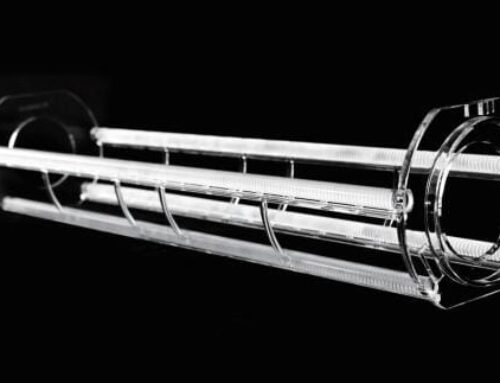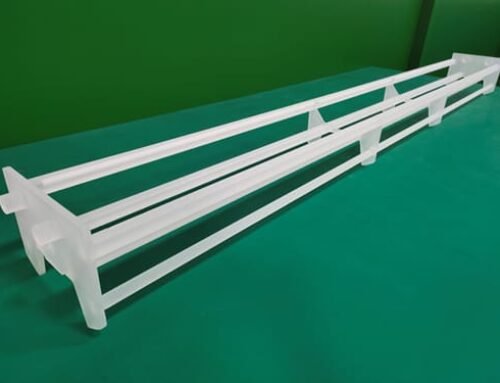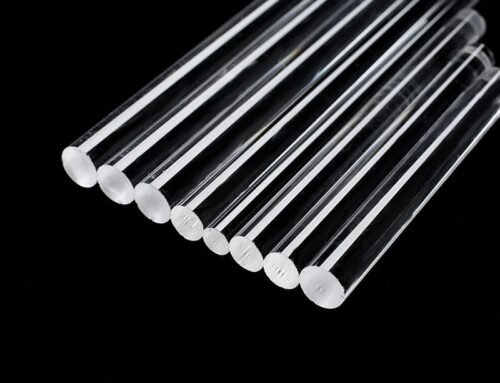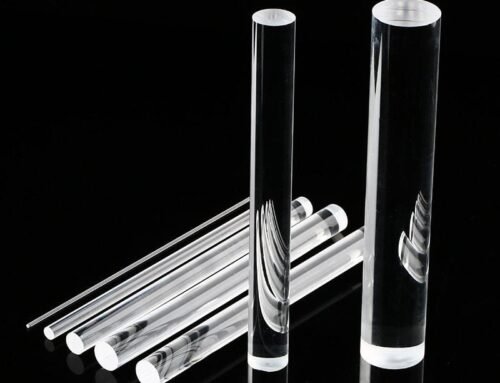Introduction to Quartz Tubes
Quartz tubes are cylindrical structures made from silicon dioxide, commonly known as quartz. These tubes are characterized by their high purity and can be manufactured in various diameters. Among the different sizes, large diameter quartz tubes are significant in a range of applications, particularly within vacuum and furnace environments. The unique properties of quartz, such as its excellent thermal resistance, low thermal expansion, and high transmission of light, make it an ideal choice for industries that require precise and durable materials under extreme conditions.
One of the most salient features of large diameter quartz tubes is their ability to withstand high temperatures, which is essential in furnace applications. These tubes can endure temperatures often exceeding 1000 degrees Celsius, which allows them to operate effectively in high-heat environments. Furthermore, quartz tubes exhibit chemical inertness, meaning they do not react with most chemicals, making them suitable for use in environments where volatile substances are present.
The versatility of quartz tubes extends to their application in various industries, including semiconductor manufacturing, chemical processing, and lighting solutions. In semiconductor fabrication, large diameter quartz tubes are employed as containers for thermal processing and chemical vapor deposition. Their clarity and purity ensure minimal contamination, which is critical in producing high-quality semiconductor materials. Additionally, these tubes are utilized in chemical processing due to their resistance to corrosive substances, ensuring the integrity of the materials being processed.
Another notable application of quartz tubes is in the field of lighting, specifically in high-intensity discharge lamps and other specialized lighting systems. The tubes’ exceptional light transmission properties enable efficient energy conversion while minimizing heat loss. Overall, large diameter quartz tubes serve a multifaceted role across various sectors, where their physical properties enhance efficiency and reliability in vacuum and furnace applications.
Properties of Quartz Tubes
Large diameter quartz tubes exhibit several essential properties that make them highly effective in various industrial applications, particularly in vacuum and furnace settings. One of the primary characteristics of quartz tubes is their remarkable thermal resistance. These tubes can withstand high temperatures without deforming or degrading, making them ideal for use in environments where heat is a critical factor. Typically, quartz can endure temperatures up to 1,000 degrees Celsius, allowing manufacturers to utilize these tubes in demanding thermal processes.
In addition to thermal resistance, the chemical stability of quartz is a significant advantage. Quartz tubes are largely inert, meaning they do not react with most chemicals and thus maintain their integrity when exposed to various substances used in industrial processes. This property ensures that the tubes do not contaminate the materials they contain, which is critical for applications requiring high purity levels.
Another key attribute of large diameter quartz tubes is their transparency to ultraviolet (UV) light. This characteristic is particularly beneficial in applications involving UV light sources, such as photochemical reactions or sterilization processes. The seamless transmission of UV light through quartz tubes enables optimal performance while ensuring the effective operation of the equipment involved.
Lastly, low expansion coefficients are integral to the functionality of quartz tubes. This property allows quartz to resist thermal shock, preventing cracks or breaks that could occur when subjected to rapid temperature fluctuations. The stability provided by quartz tubes under varying temperatures enhances overall system performance and reliability, proving indispensable in many industrial scenarios.
Manufacturing Process of Quartz Tubes
The manufacturing process of large diameter quartz tubes is a sophisticated procedure that emphasizes precision and quality. The primary raw material used in the production of these tubes is high-purity silica sand, which is chosen for its excellent optical and thermal properties. This raw material undergoes rigorous cleaning to remove any impurities that might affect the final product’s performance in vacuum and furnace applications.
The first step in the manufacturing process involves melting the purified silica sand at extremely high temperatures, typically around 1700 to 2000 degrees Celsius. During this phase, a form of molten quartz is created, which is essential for subsequent shaping processes. Once the silica has melted, it can be formed into tubes through various methodologies, including either molding, blowing, or drawing techniques. Each of these methods has its advantages, contributing to the creation of quartz tubes with specific dimensions, wall thicknesses, and finishes based on customer requirements.
Molding is often used for producing large diameter quartz tubes with complex shapes, where the molten quartz is poured into pre-formed molds. Conversely, blowing involves inflating a pre-shaped glass bubble to achieve the desired diameter and length, while drawing entails pulling the molten glass into a continuous tube shape. After the initial formation, the quartz tubes undergo annealing, a heat treatment process that relieves internal stresses and enhances their structural integrity. This phase is crucial, as it improves the durability of the tubes during high-temperature operations.
Finally, the quality control measures are essential to ascertain that the large diameter quartz tubes achieve industry standards. Inspection techniques such as visual checks, dimensional measurements, and functional testing are implemented to ensure that each tube conforms to specific tolerances and performance requirements. By adhering to these stringent manufacturing processes and quality assurance practices, manufacturers ensure the reliability and efficiency of quartz tubes in various applications, particularly in vacuum and furnace environments.
Application in Vacuum Systems
Large diameter quartz tubes play a critical role in various vacuum systems, owing to their exceptional ability to withstand low-pressure environments without compromising structural integrity. These tubes are extensively used in vacuum furnaces, where precise temperatures and atmospheres are required for the processing of various materials. The quartz composition offers high thermal resistance, enabling it to maintain stability during the intense heating cycles that are characteristic of these applications.
One of the primary utilizations of large diameter quartz tubes is in chemical vapor deposition (CVD) processes. In CVD, these tubes serve as reaction chambers where gaseous precursors react to form solid films on substrates. The low-pressure conditions facilitate the efficient deposition of materials, such as silicon and other advanced coatings, which are essential in the semiconductor and solar cell industries. The transparency of quartz also allows for monitoring processes through visual inspection, adding another layer of benefit in maintaining optimal conditions.
Moreover, large diameter quartz tubes are frequently employed in laboratory setups, where they are utilized to create controlled environments for experiments. Their capacity to maintain vacuum conditions makes them ideal for a variety of scientific applications, ranging from material synthesis to fundamental research. The inert nature of quartz aids in minimizing contamination risks, ensuring that the integrity of experiments is upheld.
In summary, the versatility and durability of large diameter quartz tubes make them indispensable in vacuum systems. Their utilization in vacuum furnaces, deposition processes, and laboratory environments highlights their significance in maintaining low-pressure conditions while enhancing performance. This capability renders them essential components in modern manufacturing and research settings, further solidifying their critical role in various industrial applications.
Role in Furnace Applications
Quartz tubes play a pivotal role in furnace applications, especially in environments that demand high temperatures and insulation performance. These tubes, characterized by their superior thermal resistance, can withstand extreme heat without deforming or losing integrity. Unlike traditional materials, large diameter quartz tubes maintain their structural integrity at temperatures exceeding 1000 degrees Celsius, making them ideal for high-temperature processes.
One of the key characteristics of quartz tubes is their excellent insulation capabilities. The low thermal conductivity of quartz material ensures minimal heat loss, creating an efficient thermal environment within the furnace. This is particularly beneficial in processes where energy consumption is critical, as it allows for better controlling of thermal cycles and reductions in overall operational costs. The insulating properties also aid in protecting sensitive electronic components or materials that may not withstand direct exposure to high temperatures.
In addition to their insulation capabilities, quartz tubes exhibit remarkable durability, which is critical in furnace applications where materials are regularly exposed to mechanical and thermal stresses. Their resistance to thermal shock prevents fractures and prolongs the life of the tube, ensuring consistent performance and reducing maintenance needs. Furthermore, the purity of quartz provides an inert environment, minimizing contamination risks. This is essential for industries relying on precise material specifications, such as semiconductor manufacturing or glass processing.
Overall, the integration of large diameter quartz tubes in furnace systems significantly enhances the efficiency and safety of thermal processes. Their unique properties not only improve energy efficiency but also ensure the longevity and reliability of furnace operations. As industries continue to prioritize sustainable practices, the role of these tubes becomes increasingly vital in achieving optimal furnace performance.
Advantages of Using Large Diameter Quartz Tubes
Large diameter quartz tubes offer a range of notable benefits that make them a preferred choice in various vacuum and furnace applications. One of the most significant advantages is their exceptional longevity. Unlike other materials, quartz tubes exhibit a remarkable resistance to degradation, even under prolonged exposure to high temperatures and aggressive environments. This durability translates into lower replacement costs and reduced downtime, which is crucial for maintaining operational efficiency in industries where these tubes are employed.
Another key characteristic of large diameter quartz tubes is their outstanding resistance to thermal shock. In many applications, rapid temperature changes can lead to material failure; however, quartz’s unique molecular structure allows it to withstand abrupt shifts in temperature without cracking or breaking. This property is particularly beneficial in furnace applications where extreme heating and cooling cycles occur frequently. As a result, quartz tubes provide reliable performance and enhance safety by minimizing the risk of sudden failures.
Furthermore, large diameter quartz tubes contribute significantly to maintaining cleanliness within processing environments. Their non-reactive surfaces do not adhere to contaminants, which is essential in industries that require high purity levels. This feature helps to minimize the risk of product contamination during production processes, ensuring that the integrity of the materials being handled is maintained. Additionally, the smooth surface of quartz facilitates easy cleaning and reduces the accumulation of particulate matter, making them an ideal choice for applications where cleanliness is paramount.
In summary, the advantages of large diameter quartz tubes, including their longevity, resistance to thermal shock, and effectiveness in maintaining cleanliness, underscore their importance in various technical applications. These properties not only enhance the performance of the systems in which they are used but also contribute to increased reliability and operational efficiency.
Challenges and Limitations
Large diameter quartz tubes play an essential role in various industrial applications, especially in vacuum and furnace processes. However, despite their advantages, there are inherent challenges and limitations associated with their use. One of the primary concerns is their fragility. Quartz, while known for its excellent thermal resistance and purity, is also brittle. This fragility makes handling and transportation of large diameter quartz tubes particularly challenging. Any impact or irregular handling can lead to cracking or shattering, necessitating stringent precautionary measures during installation and operation.
Another significant limitation is the cost associated with the production and procurement of large diameter quartz tubes. High-quality quartz is a premium material, and as the diameter of the tubes increases, the complexity and cost of manufacturing also escalate. This can be a major drawback for many organizations, particularly for small to medium-sized enterprises that may have limited budgets. In some cases, seeking alternative materials may seem like a viable option; however, these alternatives often do not match the performance specifications that quartz can deliver, especially in high-temperature environments.
Moreover, large diameter quartz tubes can experience degradation over time under certain conditions. Factors such as prolonged exposure to extreme temperatures, chemical reactions with certain substances, and environmental stressors can lead to structural weaknesses, thereby compromising their integrity. This degradation can result in performance issues and failures, which could undermine production efficiency and safety. Consequently, regular monitoring and maintenance of the quartz tubes are imperative to ensure longevity and reliability in vacuum and furnace applications.
Future Trends in Quartz Tube Technology
The field of quartz tube technology is on the precipice of significant advancements, driven by innovations in materials science and engineering. As industries reliant on large diameter quartz tubes, such as vacuum and furnace applications, continue to evolve, several emerging trends promise to reshape the landscape of this essential component. One noteworthy trend is the introduction of advanced manufacturing techniques, including additive manufacturing, which allows for the creation of complex geometries and improved material properties. This could enable the development of custom-designed quartz tubes tailored for specific applications, enhancing efficiency and performance.
In addition to manufacturing practices, the exploration of alternative materials presents an exciting avenue for future quartz tube technologies. Researchers are investigating composite materials that integrate quartz with other substances to improve thermal stability, chemical resistance, and overall durability. Such innovations could significantly reduce the weight of quartz tubes without compromising their structural integrity, offering advantages for transport and installation.
Furthermore, sustainability is becoming a central focus in the development of quartz tube technology. Manufacturers are increasingly seeking eco-friendly production practices, including the use of recycled materials and processes that minimize carbon emissions. The incorporation of sustainable practices not only aligns with global environmental goals but also caters to a growing consumer preference for greener products. As environmental regulations tighten, embracing sustainability could become a competitive differentiator in the quartz tube market.
Moreover, the rise of automation and smart technologies stands to enhance quality control and production efficiency in the quartz tube manufacturing process. By integrating sensors and machine learning, manufacturers can monitor production parameters in real-time, ensuring that every tube meets stringent quality standards. This trend toward intelligent manufacturing could create safer, more reliable, and highly efficient quartz tubes, suitable for a wider array of applications in the future.
Conclusion
In summary, large diameter quartz tubes play a vital role in both vacuum and furnace applications, significantly impacting various industrial processes. The inherent properties of quartz, such as its excellent thermal resistance, transparency to infrared radiation, and high chemical purity, make it an ideal material for constructing tubes used in these demanding environments. These tubes are not only capable of withstanding extreme temperatures but also provide an effective barrier against contamination, which is essential in processes where purity is paramount.
The utility of large diameter quartz tubes extends across various sectors, including semiconductor manufacturing, solar energy production, and materials processing. In the semiconductor industry, for instance, the precise control of temperature and environment facilitated by these tubes is crucial for the production of high-quality wafers. Similarly, in solar energy applications, large diameter quartz tubes are instrumental in the fabrication of photovoltaic cells, where the need for high performance and reliability cannot be overstated.
Furthermore, the ongoing development of technology continues to drive the demand for high-performance materials like large diameter quartz tubes. As industries seek to innovate and optimize production processes, the versatility and efficiency offered by quartz are likely to ensure its continued relevance. In conclusion, the significance of large diameter quartz tubes in vacuum and furnace applications is irrefutable, making them indispensable components in a variety of industrial settings that require precision, purity, and thermal resilience.





